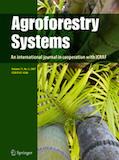
Abstract: Robust and cost effective methods for estimating aboveground biomass of trees on farms are necessary to understand the significance of this carbon pool, identify climate change mitigation opportunities and support smallholder farmers’ ability to capitalize on the emerging green economy. Using a dataset of 72 destructively sampled trees and 855 non-destructively sampled trees, we identified methodologically and economically efficient strategies to construct allometric equations and measure on-farm tree biomass. We found that robust biomass estimates can be obtained from measuring diameter at breast height (DBH) alone. Inclusion of tree height, specific wood density, and/or crown area in the allometric equation changed the biomass estimates by only 1.3 %, though these additional variables improved precision by reducing the error from 7.8 % to between 4.8 and 7.0 %. Research accuracy-to-cost trade-offs can be optimized by building equations based on destructive measurements of trees that span stem diameters found in the landscape; equations based on only small or large diameter trees result in poor estimates. Given (1) the resources required to measure additional dendrometric parameters in the field (2) the potential to introduce measurement errors that can propagate through estimates at farm and landscape scales, and (3) the need to quickly increase the amount of data available at low cost, we recommend that allometric equations for trees on farms be based solely on DBH and that the sampling strategy capture the range of tree sizes found in the landscape and future indirect quantification should focus on diameter at breast height as a predictor of biomass to save resources.








